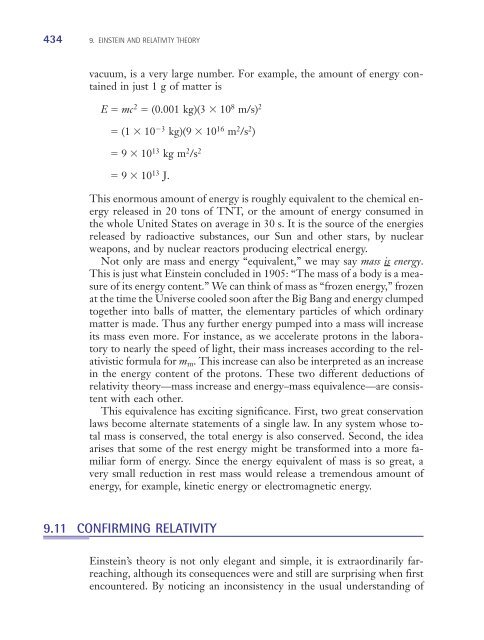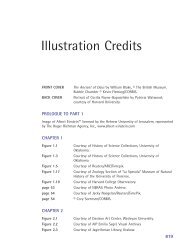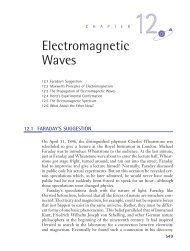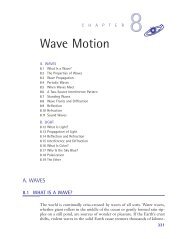Chapter 9: Einstein and Relativity Theory (319 KB) - D Cassidy Books
Chapter 9: Einstein and Relativity Theory (319 KB) - D Cassidy Books
Chapter 9: Einstein and Relativity Theory (319 KB) - D Cassidy Books
You also want an ePaper? Increase the reach of your titles
YUMPU automatically turns print PDFs into web optimized ePapers that Google loves.
3637_<strong>Cassidy</strong>TX_09 6/14/02 12:08 PM Page 434<br />
434 9. EINSTEIN AND RELATIVITY THEORY<br />
vacuum, is a very large number. For example, the amount of energy contained<br />
in just 1 g of matter is<br />
E mc 2 (0.001 kg)(3 10 8 m/s) 2<br />
(1 10 3 kg)(9 10 16 m 2 /s 2 )<br />
9 10 13 kg m 2 /s 2<br />
9 10 13 J.<br />
This enormous amount of energy is roughly equivalent to the chemical energy<br />
released in 20 tons of TNT, or the amount of energy consumed in<br />
the whole United States on average in 30 s. It is the source of the energies<br />
released by radioactive substances, our Sun <strong>and</strong> other stars, by nuclear<br />
weapons, <strong>and</strong> by nuclear reactors producing electrical energy.<br />
Not only are mass <strong>and</strong> energy “equivalent,” we may say mass is energy.<br />
This is just what <strong>Einstein</strong> concluded in 1905: “The mass of a body is a measure<br />
of its energy content.” We can think of mass as “frozen energy,” frozen<br />
at the time the Universe cooled soon after the Big Bang <strong>and</strong> energy clumped<br />
together into balls of matter, the elementary particles of which ordinary<br />
matter is made. Thus any further energy pumped into a mass will increase<br />
its mass even more. For instance, as we accelerate protons in the laboratory<br />
to nearly the speed of light, their mass increases according to the relativistic<br />
formula for m m . This increase can also be interpreted as an increase<br />
in the energy content of the protons. These two different deductions of<br />
relativity theory—mass increase <strong>and</strong> energy–mass equivalence—are consistent<br />
with each other.<br />
This equivalence has exciting significance. First, two great conservation<br />
laws become alternate statements of a single law. In any system whose total<br />
mass is conserved, the total energy is also conserved. Second, the idea<br />
arises that some of the rest energy might be transformed into a more familiar<br />
form of energy. Since the energy equivalent of mass is so great, a<br />
very small reduction in rest mass would release a tremendous amount of<br />
energy, for example, kinetic energy or electromagnetic energy.<br />
9.11 CONFIRMING RELATIVITY<br />
<strong>Einstein</strong>’s theory is not only elegant <strong>and</strong> simple, it is extraordinarily farreaching,<br />
although its consequences were <strong>and</strong> still are surprising when first<br />
encountered. By noticing an inconsistency in the usual underst<strong>and</strong>ing of






